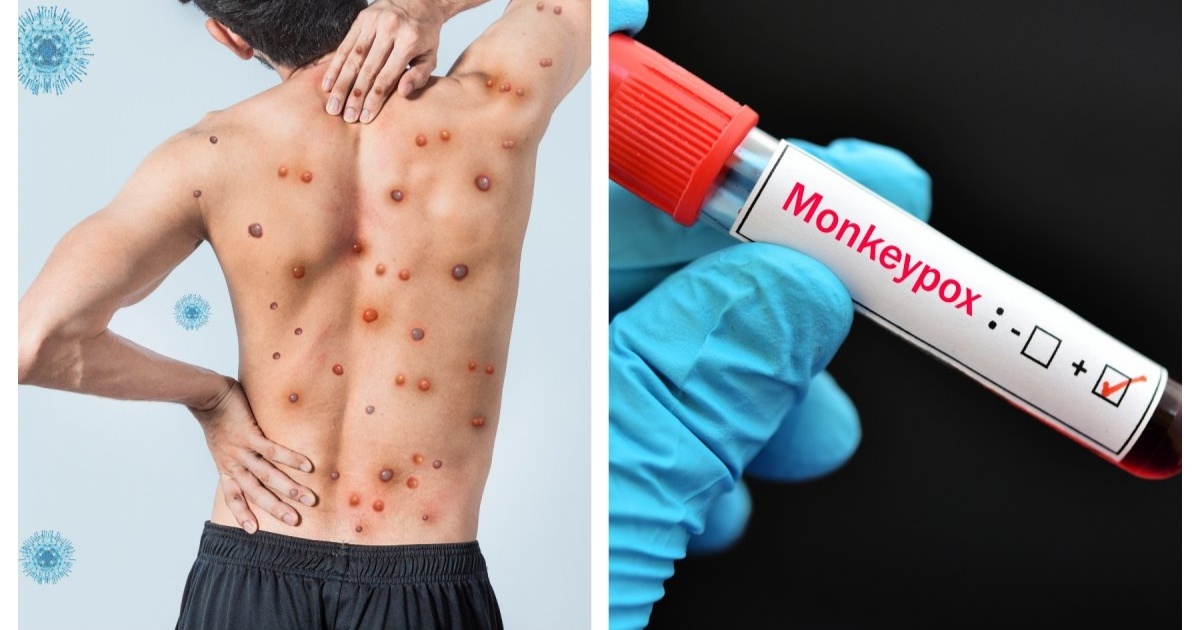As the world continues to grapple with various health challenges, the emergence of the monkeypox virus has added another layer of complexity to global health security.
Monkeypox, a zoonotic viral disease, has recently garnered significant attention due to its outbreas in regions where it was previously rare. In this blog, we'll explore everything you need to know about the ongoing monkeypox pandemic, from its origins and symptoms to prevention and treatment strategies.
What is Monkeypox?
Mpox, formerly known as monkeypox, is a rare viral disease caused by the mpox virus, which belongs to the Orthopoxvirus genus, the same family as the virus that causes smallpox. Although it shares some similarities with smallpox, such as the development of rashes and flu-like symptoms, mpox is generally less severe.
The virus was first discovered in 1958 when two outbreaks of a pox-like disease occurred in colonies of monkeys kept for research, hence the name "monkeypox."
The first human case of monkeypox was recorded in 1970 in the Democratic Republic of Congo. Since then, sporadic cases have been reported in Central and West African countries, where the virus is endemic.
The disease is zoonotic, meaning it can be transmitted between animals and humans. Mpox is endemic to parts of Central and West Africa, where it is regularly found in small rodents, monkeys, and other mammals.
There are two known types (clades) of the mpox virus: Clade I, which originated in Central Africa, and Clade II, which originated in West Africa. The ongoing global outbreak (2022 to 2023) is caused by Clade IIb, a subtype of the less severe West African clade.
Mpox is primarily spread through close contact with an infected person or animal. While it was historically confined to Africa, recent years have seen an increase in cases in regions outside of Africa, including the United States, Europe, and Australia.
Although anyone can contract mpox, recent outbreaks have shown a higher prevalence among men who have sex with men (MSM) outside of Africa, though the virus can affect individuals of all demographics.
However, the recent outbreak has spread to non-endemic countries, raising concerns about its potential to become a global health threat.
How is Monkeypox Transmitted?
Monkeypox is primarily a zoonotic disease, meaning it is transmitted from animals to humans. The virus is commonly found in various wild animals, including rodents and primates.
Human infections occur when an individual comes into direct contact with the blood, bodily fluids, or cutaneous or mucosal lesions of infected animals.
Human-to-human transmission is also possible, primarily through respiratory droplets during prolonged face-to-face contact or through direct contact with bodily fluids, lesions, or contaminated materials like bedding or clothing.
Although not as easily transmissible as viruses like COVID-19, monkeypox can spread within communities, especially in close-contact settings.
Symptoms of Monkeypox
Mpox, formerly known as monkeypox, presents with a variety of symptoms that typically appear within 21 days of exposure to the virus.
The most common sign of mpox is a rash, which can develop on various parts of the body, including the hands, feet, chest, face, mouth, and near the genitals, such as the penis, testicles, labia, vagina, and anus.
The rash often goes through several stages before healing, starting as pimples or blisters that may be painful or itchy and eventually forming scabs.

In addition to the rash, other symptoms of mpox may include:
- Fever
- Chills
- Swollen lymph nodes
- Exhaustion
- Muscle aches and backache
- Headache
- Respiratory symptoms (e.g., sore throat, nasal congestion, or cough)
Not everyone with mpox will experience all these symptoms. Some individuals may only exhibit a few of them. Typically, if you develop flu-like symptoms, a rash will appear 1 to 4 days later. The incubation period, during which a person does not show symptoms, ranges from 3 to 17 days.
A person with mpox can spread the virus to others from the onset of symptoms until the rash has fully healed and a new layer of skin has formed.
Recent data also suggests that some individuals may be able to spread the virus one to four days before symptoms appear, although it's unclear how many people this has affected during the ongoing outbreak that began in 2022.
Currently, there is no evidence to suggest that asymptomatic individuals can spread the virus. The Centers for Disease Control and Prevention (CDC) continues to monitor the latest information regarding the transmission of mpox.
Current Outbreak: What’s Different?

The current mpox outbreak is particularly concerning due to several unique factors. Mpox is characterized by two genetic clades: Clade I and Clade II. Clade II was responsible for a global outbreak between July 2022 and May 2023, which led to its declaration as a global health emergency. However, the new outbreak is driven by Clade I, which causes more severe disease.
The specific subtype responsible for most of the ongoing spread, Clade Ib, is relatively new and has shown concerning characteristics. According to experts, Clade Ib has emerged as a mutation that is better adapted to humans, making it more capable of spreading from person to person and driving larger outbreaks. Unlike earlier strains, this clade is not limited to animal-to-human transmission but has evolved to spread more efficiently among humans.
What makes the situation even more complex is that this outbreak involves multiple overlapping outbreaks of different clades in different countries, each with varying modes of transmission and levels of risk. This multifaceted nature of the outbreak has raised significant concerns among global health officials.
In addition to the more severe Clade I, the broader international spread of mpox is alarming. While historically confined to Central and West Africa, mpox has now been reported in more countries across Africa that were previously unaffected, as well as in Europe and North America. This broader geographic spread, coupled with the emergence of a more virulent strain, underscores the urgent need for a coordinated global response to contain the outbreak and prevent further spread.
The World Health Organization (WHO) has declared this outbreak a global health emergency, reflecting the serious risks it poses. The evolving nature of the virus, its potential for widespread transmission, and the challenges in surveillance and diagnostics all contribute to the heightened concern surrounding this outbreak.
Prevention and Treatment
Prevention
Vaccination: Data suggest that prior immunization with the smallpox vaccine may have a protective effect against the mpox virus and may improve clinical outcomes for those infected. There are currently three smallpox vaccines in the U.S. Strategic National Stockpile that may be used for mpox prevention:
-
JYNNEOSTM (also known as IMVAMUNE, IMVANEX, MVA-BN): This is a live, non-replicating vaccine that was licensed by the U.S. Food and Drug Administration (FDA) in September 2019. It is indicated for the prevention of smallpox and mpox in adults 18 years or older who are at high risk of infection. Historical data suggest that smallpox vaccination with vaccinia virus was approximately 85% effective against mpox.
-
ACAM2000®: This vaccine consists of live, replicating vaccinia virus and is indicated for active immunization against smallpox. It can be used under an Emergency Use Authorization (EUA) for mpox during outbreaks. However, ACAM2000® has certain risks, such as the potential for inadvertent inoculation and adverse effects like myopericarditis and progressive vaccinia, making it less suitable for immunocompromised individuals.
-
Aventis Pasteur Smallpox Vaccine (APSV): This is a replication-competent vaccinia vaccine that may be used under an Investigational New Drug (IND) protocol or EUA if other licensed vaccines are unavailable or contraindicated.
Pre-exposure Prophylaxis (PrEP): The Advisory Committee on Immunization Practices (ACIP) recommends vaccination for certain individuals at risk for occupational exposure to orthopoxviruses, such as research laboratory personnel, clinical laboratory personnel performing diagnostic testing for orthopoxviruses, and designated response team members. Healthcare personnel who administer ACAM2000® or care for patients infected with replication-competent orthopoxviruses can also be offered vaccination based on shared clinical decision-making.
Post-exposure Prophylaxis (PEP): The Centers for Disease Control and Prevention (CDC) recommends that the first dose of the vaccine be administered within 4 days of exposure to prevent the onset of mpox. If administered between 4 and 14 days after exposure, the vaccine may reduce the severity of symptoms but may not prevent the disease. High-degree exposures (e.g., unprotected contact with an infected person's skin or bodily fluids) warrant PEP vaccination and monitoring.
Treatment
Supportive Care: Most individuals with mpox recover without the need for medical treatment. Supportive care includes managing symptoms like fever and providing oral or intravenous rehydration to counteract gastrointestinal symptoms like vomiting and diarrhea.
Antiviral Medications: Several antiviral medications may be effective in treating mpox, although their use is primarily based on data from smallpox treatment studies:
-
Tecovirimat (TPOXX or ST-246): This antiviral is considered the treatment of choice for smallpox and is available through the Strategic National Stockpile. Tecovirimat works by inhibiting the viral envelope protein VP37, preventing the virus from spreading within the infected host. Although its efficacy against mpox has not been tested in humans, studies in animal models have shown improved survival rates.
-
Brincidofovir: Approved for smallpox treatment in the U.S., brincidofovir is an oral analogue of the intravenous drug cidofovir. It may have a better safety profile, particularly with less renal toxicity. However, its use for mpox treatment is still under investigation, and liver function tests are recommended during treatment due to potential increases in serum transaminases and bilirubin.
-
Cidofovir: This antiviral is used intravenously and works by inhibiting viral DNA polymerase. While effective in animal models, clinical data on its efficacy against mpox in humans are lacking. It requires concurrent use of intravenous normal saline and probenecid therapy to reduce nephrotoxicity.
Vaccinia Immune Globulin (VIG): VIG is a hyperimmune globulin licensed by the FDA for treating complications of vaccinia vaccination, such as eczema vaccinatum and progressive vaccinia. Although its effectiveness against mpox is not well-documented, it may be considered for use in certain cases under an IND application, especially in immunocompromised individuals exposed to the virus.
Currently, there is no specific treatment for monkeypox, but supportive care can help alleviate symptoms. In severe cases, antiviral medications like Tecovirimat may be used under specific conditions. Most patients recover fully without the need for extensive medical intervention.
Global Response and Future Outlook
The recent outbreak of a more severe strain of mpox, known as clade Ib, has prompted an urgent and coordinated global response. The World Health Organization (WHO) has declared the situation a Public Health Emergency of International Concern (PHEIC), the highest level of alarm under international health law. This declaration reflects the serious threat posed by the rapid spread of this deadlier strain to previously unaffected countries in Africa, and the potential for further global transmission.
WHO Director-General Tedros Adhanom Ghebreyesus emphasized the gravity of the situation, noting the detection of the new clade in eastern Democratic Republic of Congo (DRC) and its spread to neighboring countries. He described the outbreak as an "extraordinary event" and highlighted the need for a coordinated international response to contain the virus and prevent further escalation.
The Africa Centres for Disease Control and Prevention also recognized the severity of the outbreak by declaring it a public health emergency of continental security. This marks the first such declaration by the agency since its inception in 2017, underscoring the high level of concern across the continent.
The current outbreak is particularly alarming due to the presence of multiple, overlapping outbreaks of different mpox clades in various countries, each with its own mode of transmission and risk level. While clade II was responsible for the global outbreak in 2022, the new clade Ib is causing more severe disease and presents a greater challenge to public health systems.
To combat the spread of the virus, the WHO has called for increased international cooperation in financing, organizing, and supporting efforts to contain the outbreak. This includes funding research to better understand the characteristics of clade Ib and its transmission dynamics. The WHO has signed off on the Emergency Use Listing process for mpox vaccines and developed a regional response plan requiring $15 million, with $1.5 million already released from the WHO Contingency Fund for Emergencies.
In terms of vaccine availability, half a million doses are currently in stock, with an additional 2.4 million doses potentially available by the end of the year. The DRC and Nigeria will be the first to receive these vaccines, as part of the initial response to the outbreak. However, WHO officials stressed that vaccines alone are not sufficient to stop the spread of the virus. A comprehensive approach that includes increased surveillance, diagnostics, and research is essential to fill the existing gaps in understanding and effectively combat the outbreak.
Looking forward, WHO officials, including Dr. Maria Van Kerkhove, Director of the WHO’s Department of Epidemic and Pandemic Preparedness and Prevention, expressed cautious optimism. They believe that with a concerted global effort and the right strategies, transmission of mpox can be stopped. However, they also acknowledged the significant uncertainty that remains and emphasized the need to leverage the current moment to support research and enhance preparedness.
In summary, the global response to the mpox outbreak is characterized by a sense of urgency and the recognition that international cooperation is crucial to containing the virus. The future outlook hinges on the effectiveness of these coordinated efforts, the availability and distribution of vaccines, and the continued research to close knowledge gaps about the virus and its spread. With the right actions taken promptly, there is hope that the outbreak can be controlled and lives can be saved.
Conclusion
The ongoing mpox outbreak serves as a stark reminder of the complexities and challenges that global health faces today. What was once a relatively contained zoonotic disease in parts of Africa has now become a global concern, driven by the emergence of new, more virulent strains and the broader international spread of the virus. As we have seen, the virus can affect anyone, and the evolving nature of the outbreak requires a coordinated, multifaceted response.
Prevention through vaccination, particularly for those at higher risk, and timely treatment with antiviral medications are critical strategies in controlling the spread and impact of the virus. However, these efforts must be supported by increased global surveillance, research, and international cooperation. The World Health Organization’s declaration of a Public Health Emergency of International Concern underscores the severity of the situation and the need for immediate and sustained action.
While the situation is serious, there is also a sense of cautious optimism. With the right global strategies in place, including widespread vaccination, research to better understand the virus, and strong public health measures, the spread of mpox can be contained. The key to overcoming this outbreak lies in the global community’s ability to work together, share resources, and respond swiftly to the challenges posed by this virus.
As we move forward, it is essential to remain vigilant and proactive. By staying informed, following public health guidelines, and supporting efforts to contain the virus, we can mitigate the impact of mpox and protect global health security. The lessons learned from this outbreak will be crucial in preparing for and preventing future pandemics.
References
What is mpox, and why is this outbreak so concerning?
Prevention and Treatment of Monkeypox
WHO declares mpox outbreak a global health emergency














